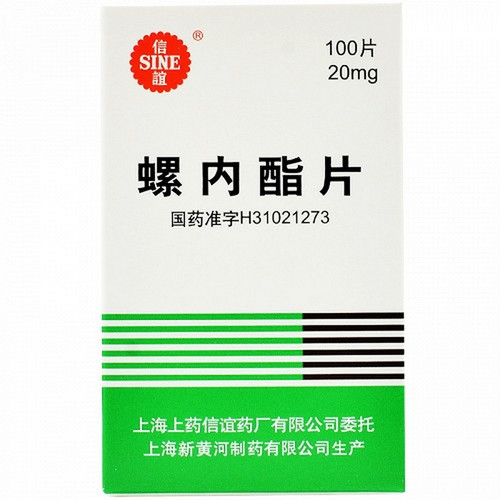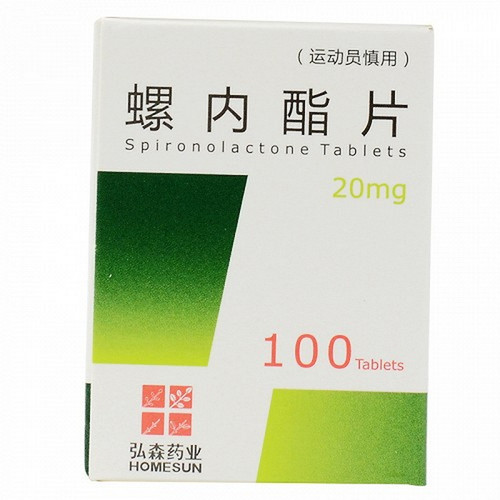Product Overview
[Drug Name]
Generic Name: Spironolactone Tablets
Trade Name: Minsheng Spironolactone Tablets 20mg x 100 Tablets
Pinyin Code: LuoNeiZhiPian (MinSheng)
[Main Ingredient]
The main ingredient of this product is spironolactone.
[Properties]
This product is a white tablet.
[Indications/Main Functions]
1. Edema: Used in combination with other diuretics to treat edema such as congestive edema, ascites due to cirrhosis, and renal edema. The purpose is to correct the secondary increased aldosterone secretion associated with these conditions and counteract the potassium-excreting effects of other diuretics. It is also used to treat idiopathic edema. 2. Hypertension: As an adjunctive drug for the treatment of hypertension. 3. Primary Aldosteronism: Spironolactone can be used for the diagnosis and treatment of this condition. 4. Prevention of Hypokalemia: Used in combination with thiazide diuretics to enhance the diuretic effect and prevent hypokalemia.
[Precautions]
1. This drug can cross the placenta, but its effects on the fetus are unknown. Pregnant women should use this drug under the guidance of a physician, and the duration of use should be as short as possible. 2. Elderly individuals are more susceptible to hyperkalemia and excessive diuresis. 3. Interference with Diagnosis: ① It may increase plasma cortisol concentrations measured by fluorescence. Therefore, this drug should be discontinued 4-7 days before blood collection or an alternative measurement method should be used. ② It may increase the following measurement values: plasma creatinine and urea nitrogen (especially in patients with pre-existing renal impairment), plasma renin, serum magnesium, and potassium. Urinary calcium excretion may increase, while urinary sodium excretion may decrease. 4. This drug is contraindicated in patients with hyperkalemia. 5. Use with caution in the following conditions: ① Anuria; ② Renal insufficiency; ③ Hepatic insufficiency, as electrolyte imbalances caused by this drug may induce hepatic coma; ④ Hyponatremia; ⑤ Acidosis. On the one hand, acidosis may aggravate or precipitate hyperkalemia caused by this drug; on the other hand, this drug may aggravate acidosis; ⑥ Breast enlargement or menstrual disorders.
[Drug Interactions]
Contraindicated in patients with hyperkalemia.
[Pediatric Use]
This study has not been conducted and no reliable references are available.
[Elderly Use]
Elderly patients are more susceptible to hyperkalemia and excessive diuresis.
[Pregnant and Lactating Women Use]
This drug can cross the placenta, but its effects on the fetus are unknown. Pregnant women should use this drug under the guidance of a physician and for the shortest possible duration.
[Specifications]
20mg x 100 tablets
[Dosage and Administration]
1. Adults ① For the treatment of edematous diseases, take 40-120 mg daily in 2-4 divided doses for at least 5 consecutive days. Adjust the dose as appropriate thereafter. ② For the treatment of hypertension, start with 40-80 mg daily in divided doses for at least 2 weeks, and adjust the dose as appropriate thereafter. It should not be used in combination with angiotensin-converting enzyme inhibitors to avoid increasing the chance of hyperkalemia. ③ For the treatment of primary aldosteronism, preoperative patients should take 100-400 mg daily in 2-4 divided doses. For patients who are not suitable for surgery, a smaller dose should be used for maintenance. ④ For the diagnosis of primary aldosteronism. For long-term trials, take 400 mg daily in 2-4 divided doses for 3-4 consecutive weeks. For short-term trials, take 400 mg daily in 2-4 divided doses for 4 consecutive days. The elderly are more sensitive to this drug, so the initial dose should be smaller. 2. Pediatric: For the treatment of edematous diseases, initially take 1-3 mg/kg body weight or 30-90 mg/m² per body surface area daily, in a single dose or divided into 2-4 divided doses. After 5 consecutive days, adjust the dose as appropriate. The maximum dose is 3-9 mg/kg or 90-270 mg/m² per day.
[Adverse Reactions]
1. Common side effects include: ① Hyperkalemia, which is the most common, especially when used alone, in conjunction with a high-potassium diet, with potassium supplements or potassium-containing medications such as penicillin potassium, and in the presence of renal impairment, oliguria, or anuria. Even with concomitant use of thiazide diuretics, the incidence of hyperkalemia can reach 8.6%-26%, often with cardiac arrhythmias as the initial manifestation. Therefore, close monitoring of serum potassium and electrocardiograms is essential during treatment. ② Gastrointestinal reactions, such as nausea, vomiting, stomach cramps, and diarrhea. There have also been reports of peptic ulcers. 2. Rare side effects include: ① Hyponatremia, which is rare when used alone but increases in incidence when used in combination with other diuretics; ② Antiandrogenic effects or effects on other endocrine systems. Long-term use of this drug can cause gynecomastia, impotence, and sexual dysfunction in men, and breast tenderness, hoarseness, increased hair growth, menstrual disorders, and decreased sexual function in women; ③ Central nervous system effects: Long-term or high-dose use of this drug can cause gait incoordination and headaches. 3. Rare side effects include: ① Allergic reactions, including rashes and even dyspnea; ② Transient elevations in plasma creatinine and urea nitrogen, primarily related to excessive diuresis, insufficient effective blood volume, and decreased glomerular filtration rate; ③ Mild hyperchloremic acidosis; ④ Tumors. Five patients have been reported to develop breast cancer after long-term use of this drug and hydrochlorothiazide.
[Contraindications]
This drug is contraindicated in patients with hyperkalemia.
[Overdose]
The current status is unknown.
[Pharmacology and Toxicology]
This drug is structurally similar to aldosterone and is a competitive inhibitor of aldosterone. It acts in the distal convoluted tubule and collecting duct, blocking Na+-K+ and Na+-H+ exchange. This results in increased excretion of Na+, Cl-, and water, decreased excretion of K+, Mg2+, and H+, and variable effects on Ca2+ and P3-. Because this drug acts only in the distal convoluted tubule and collecting duct, with no effect on other segments of the renal tubule, its diuretic effect is relatively weak. Furthermore, this drug also has effects on aldosterone target organs outside the renal tubules.
[Pharmacokinetics]
This drug is well absorbed orally, with a bioavailability exceeding 90% and plasma protein binding exceeding 90%. After administration, 80% of it is rapidly metabolized by the liver to active canrenone. Effectiveness begins approximately one day after oral administration, peaks two to three days later, and the effect persists for two to three days after discontinuation. T1/2 varies depending on the route of administration, averaging 19 hours (13-24 hours) when taken once or twice daily and shortened to 12.5 hours (9-16 hours) when taken four times daily. Inactive metabolites are excreted through the kidneys and bile duct, with approximately 10% excreted unchanged through the kidneys.








